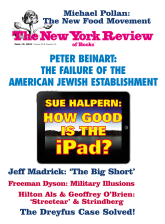Not the least striking revelation of Michael Lewis’s excellent book, The Big Short, is that this author of financial best-sellers has changed his mind. In a column for Bloomberg News in early 2007, he praised the rapidly expanding market for derivatives. Visiting the annual meeting of financiers and policymakers at the World Economic Forum in Davos, Switzerland, that year, he was exasperated by the fears of some of the participants. “None of them seemed to understand that when you create a derivative you don’t add to the sum total of risk in the financial world,” he wrote, sounding arguments very similar to those made by Alan Greenspan. “You merely create a means for redistributing that risk. They have no evidence that financial risk is being redistributed in ways we should all worry about.”
As we now know, derivatives were the instruments that enabled Wall Street to stretch capital dangerously far—and were at the center of the financial crisis that began that year. They are investment contracts between two parties based on other securities, which require little capital up-front, enabling buyers and sellers to take temporary large investment stakes inexpensively, including in mortgage securities. “What we have found over the years in the marketplace is that derivatives have been an extraordinarily useful vehicle to transfer risk from those who shouldn’t be taking it to those who are willing to and are capable of doing so,” Greenspan told Congress in 2003. Lewis wrote in 2007: “The most striking thing about the growing derivatives markets is the stability that has come with them.”
Soon after Lewis’s column, the housing market crashed. Then, in the fall of 2008, the financial markets collapsed as well, business lending worldwide came to a standstill, and Lewis apparently began to reconsider practically everything he had written on this subject. He heard that a hedge fund manager named John Paulson made $4 billion betting against mortgages by means of derivatives. “It was late 2008,” he writes in The Big Short. “By then there was a long and growing list of pundits who claimed they predicted the catastrophe, but a far shorter list of people who actually did.” Lewis, whose first book, Liar’s Poker (1989), was a revealing insider’s account of the beginnings of the new mortgage markets, decided to find out what the handful of people who did “stand apart from mass hysteria” understood that others didn’t.
Through these contrarians, he untangles in depth the sources of the crisis in ways that none of the recent literature on the subject has matched. Lewis shows that abstract principles govern the affairs of men much less than do plain, homely, and base human motives. The financial crisis, he concludes, was the work of people on Wall Street and mortgage brokers who acted in their self-interest without fear of either legal or economic reprisal. Whereas former treasury secretary Robert Rubin argued that “we all bear responsibility for not recognizing” the “possibility of a massive crisis,” Lewis shows that it was indeed possible to know what was going on—and more to the point, that the most dangerous activities in financial markets could have been stopped.
The recent Securities and Exchange Commission suit against Goldman Sachs, which alleges that John Paulson chose the risky mortgage bonds that Goldman bundled together and deliberately sold to others, will not surprise readers of this book. Paulson made a billion dollars by betting against derivatives based on those bonds, and Goldman’s investors lost a billion dollars. It was a small drop in a dark ocean.
This Issue
June 10, 2010
-
*
Crisis Economics: A Crash Course in the Future of Finance (Penguin, 2010).
↩





